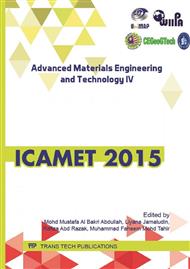p.524
p.530
p.535
p.540
p.547
p.555
p.560
p.565
p.573
Acid Treatment of Aluminium Dross: Properties and Application
Abstract:
This research work aimed to apply the aluminium dross, waste of ADC12 and 6063 aluminium smelter grade as the raw materials produced plant fertilizer by acid treatment process with phosphoric and hydrochloric acid. Chemical properties have been tested as a chemical composition, pH, amount of macronutriants and heavy metals. The germination index testing was confirmed by using water extraction of the dross before and after pretreatment which effected on cantonese green lettuce seed. The results showed that more than 50% by weight of dross composition was alumina mainly. Others components were included oxides of silicon, magnesium, sodium, potassium, calcium, iron, and zinc. Interestingly, there are not appeared of harmful heavy metal elements. For fertilization properties, mainly nutrients as nitrogen (N), phosphorus (P), and potassium (K) were investigated. Also, the germination test was investigated in an organic fertilizer standard test method as germination index (GI). Normally, the result was found that GI of un-treated dross was lower than that of a control sample. The treated dross with HCl and phosphoric acid presented higher GI than that of a reference sample. It was concluded that both grades of dross can be used as a fertilizer with acid treatment.
Info:
Periodical:
Pages:
547-552
Citation:
Online since:
May 2016
Keywords:
Price:
Сopyright:
© 2016 Trans Tech Publications Ltd. All Rights Reserved
Share:
Citation:


